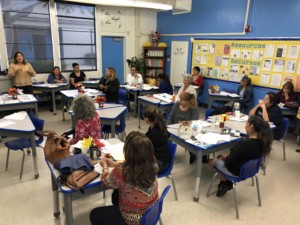Engaging Parents to Engage Learners: Digital Portfolios Can Make it Happen

By Chris Besse
The ESSA mandates that school districts show efforts to engage parents in their child’s learning. This mandate allows for multiple solutions, and technology is one method districts are using to make parent engagement efforts more effective. One effective solution now being used is the digital portfolio, a solution that allows parents to actively engage in their child’s learning as it happens.
Digital portfolios push updates to parents instead of expecting them to check. They connect parents with what is happening in the classroom and, perhaps most importantly, start conversations between students and parents – focused on helping them improve. This is an important step in changing the dinner table conversation from “What did you do at school today,” to “Tell me about the project I saw in your portfolio.”
A good example is the Wolf Creek Local School District, which my organization worked with, and which held parent-teacher interviews every eight weeks. Once they started using digital portfolios, the conferences became more open and relaxed. Both parents and teachers felt meetings were quick, friendly check-ins rather than formal meetings. Getting information over time about their child’s progress removed the shock factor and served as a continuation of an ongoing discussion, resulting in quicker visits and improved teacher-parent relationships.
Chris Thompson from the Elmbrook School District in Wisconsin has noticed a remarkable increase in parent engagement using digital portfolios. “At Elmbrook Schools, we have a highly-engaged parent population. When we looked at portfolio solutions, the range of needs went from presentation portfolios to daily work portfolios. We chose the latter,” he says.
“The expectation in elementary is that teachers will communicate with parents about once per week about class work and give a class update. In some classrooms, parents are invited to their child’s portfolio, and they are coached by teachers on how to give feedback through ‘Parent PD’ and information nights. Parents love knowing where their child is in their learning journey. At parent-teacher conferences it’s easy to pull out the iPad and walk them through their child’s progress if they aren’t following along. Often students take ownership of this process and share their work with parents and peers directly.”
Educators know that having parents involved in education is an important part of student success. Portfolios can provide a seamless environment to allow parents into the classroom to observe not only what, but how their children are learning. “I believe the real power lies in how digital portfolios connect home and school,” says 6th and 7th Grade teacher Rob Heinrichs.
“One small example can be found in how parents have responded to the speeches my students have done this week. I took video of every student performing their speeches and posted to their individual portfolios. Parents were able to watch their child’s speech only minutes after their child performed it for the class. They were also able to give their child feedback right away.” Today’s digital portfolios are easy for parents to navigate. Most parents are already familiar with apps and are comfortable in the digital world. Portfolios are easy to use, and offer support for parents to enjoy the level of engagement they are comfortable with.
Digital Portfolios for Assessment
Learning Management Systems (LMSs) have also demonstrated effectiveness in parent communication, but the very nature of the LMS can dictate limits that a portfolio system can overcome. Most Learning Management Systems are focused on communication as a two-way conversation regarding classroom notices – things that can be sent in a letter or discussed on a phone. A digital portfolio focuses the conversation on student learning: a visible conversation between the parent, student, and teacher.
According to Damian Cooper, an independent education consultant who specializes in helping schools and districts improve their instructional and assessment skills, “When we listen to students engaged in conversation related to their learning, we literally ‘see into their thinking.’ We learn about their level of understanding, their misconceptions, their tolerance for other perspectives and points of view, their ability to listen to and build on the ideas of others, their ability to answer questions… I could go on. And if we videotape these conversations, then we have rich evidence of learning as the basis for providing feedback and self-assessment that will lead to improvement.”
As Damian puts it, “Gathering, analyzing, and sharing digital evidence of [learning-focused] observations and conversations is the future of educational assessment.”
And while districts take cyber safety and the security of their students very seriously, with most student portfolios, student data is encrypted and accounts are protected by individual password-protected accounts. Access is limited to parents, the student, and teachers who are directly involved with them, and accounts are generally managed by the SIS for safety.
From a superintendent’s perspective, the digital portfolio expands on current methods for communicating student learning and makes learning visible for non-quantifiable skills and competencies. It is also a good way to help students self-reflect. From a parent’s perspective, the digital portfolio allows them to be informed when their child is excelling or struggling, to understand the next steps in their child’s learning journey, to feel like part of the classroom community and to know what’s going on without having to come to school or track down a teacher by telephone.
The thought of capturing learning in the classroom through video, audio or saved documents and then opening that experience immediately to a parent is exciting for teachers. They enjoy the immediate online feedback parents are giving to their students, as well as direct feedback from parent to teacher. Parents are finding they no longer need to wait for teacher conferences or report cards to discover how their child is doing in school. Digital portfolios are bringing parents into the classroom in a very powerful way.
Chris Besse is President and COO of FreshGrade Education Inc. Follow him on Twitter @FreshGradeChris.
For more on digital portfolios, see:
- 10 Tools to Create Online Student Portfolios
- 3 Lessons Learned Building Student Digital Portfolios
- Goodbye Resumes, Hello Digital Portfolios
Stay in-the-know with all things EdTech and innovations in learning by signing up to receive the weekly Smart Update.



0 Comments
Leave a Comment
Your email address will not be published. All fields are required.